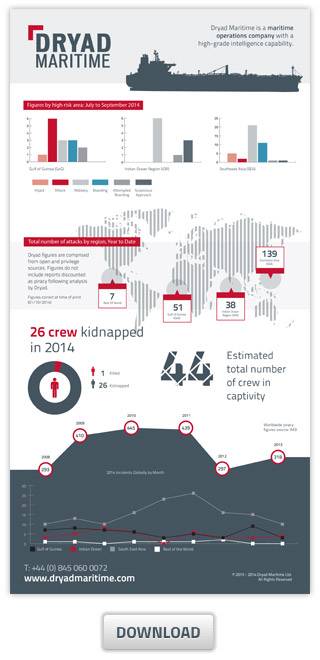Dyrad Releases Latest Piracy Statistics
UK-based maritime intelligence provider, Dryad Maritime has released its Q3 maritime crime figures which show that piracy is continuing across the globe at similar levels to Q2, with incidents of cargo theft in Southeast Asia continuing to rise.
Dryad’s figures show a 27% drop in crime overall between Q2 to Q3, but point to the continuing attacks that are happening across the globe as reported in Q2.
Maritime crime across Southeast Asia continues at pace during the period, with a further five hijackings of product tankers in the vicinity of Singapore. In addition, a further eight vessels were boarded while at anchor, taking the total number of similar incidents to 30 so far in 2014 although recent reports indicate that another tanker is currently missing since 3 October, presumed hijacked. By contrast, in 2013, there were just nine incidents in the same period. In Indonesia, however, the number of incidents has fallen from 18 to five: a drop that Dryad Maritime attributes to the improved patrols and policy by the Indonesian Maritime Police.
Ian Millen, Dryad Maritime’s Chief Operating Officer: “The number of attacks across the globe shows that maritime crime and piracy remain a threat to the shipping industry, with both cargo theft and kidnapping high on the agenda for organized criminal gangs. We can expect to see a continuation in incidents of boarding and cargo theft in Southeast Asia and in the Gulf of Guinea as criminal groups continue to prey upon the vulnerable and the unprepared.”
The Gulf of Guinea has seen 15 confirmed criminal incidents, compared with 22 in Q1 and 14 in Q2. After the surge in kidnap incidents reported in Q1, there followed a brief respite before two attacks during July and August. As is the trend of this type of incident, both took place after midnight in areas just outside of the area policed by the Nigerian Navy. Also following the trend identified in Q2, maritime criminality continues to shift west to the border area between Ghana and Togo as demonstrated by the hijacking and subsequent cargo theft of the tankers MT Haisoon 6 and MT Fair Artemis.
“The intent to hijack tankers remains, with the hijacking and cargo theft of MT Haisoon in July and a failed attempt on the MT SP Boston in August. At the time of writing, another suspect vessel is on the loose, probably looking for a victim off Gabon or even further south. In the Gulf of Guinea region, we’ve also been concerned about the West African Ebola outbreak and have made sure that our clients understand the extent of the problem and the implications for the shipping industry and individual ships’ crews.” In contrast, and in keeping with the Southwest Monsoon period in the Horn of Africa, the high wind speeds and waves in excess of five metres in the Indian Ocean / Arabian Sea and Gulf of Aden has precluded Somali piracy operations. However, the Monsoon conditions have not affected the Southern Red Sea and the Gulf of Oman with 16 reported approaches, none of which have been categorised as piracy incidents by Dryad.
“With calm seas and light winds forecast over the next few months, conditions will be morefavourable for pirate operations. However, a lack of funding, equipment and manpower is likely to limit the number of Pirate Action Groups at sea. There is potential for pirate operations to recommence in the southern regions of Somalia, where the advantage of relatively easy access to the southern Somali Basin and areas off Mombasa and Dar es Salaam and the distance from concentrations of naval forces in the Gulf of Aden, make this a more likely hunting ground. Pirates haven’t struck in the areas patrolled by naval vessels for some considerable time now, but have been unable to put to sea in other areas due to the adverse weather conditions. The next few weeks will show whether Somali criminals try their luck in open ocean areas. We will continue to advise all of our clients to maintain a distance of at least 300 nautical miles from shore when transiting along the eastern coastline of Somalia, to make it less likely that they will fall prey,” adds Ian












